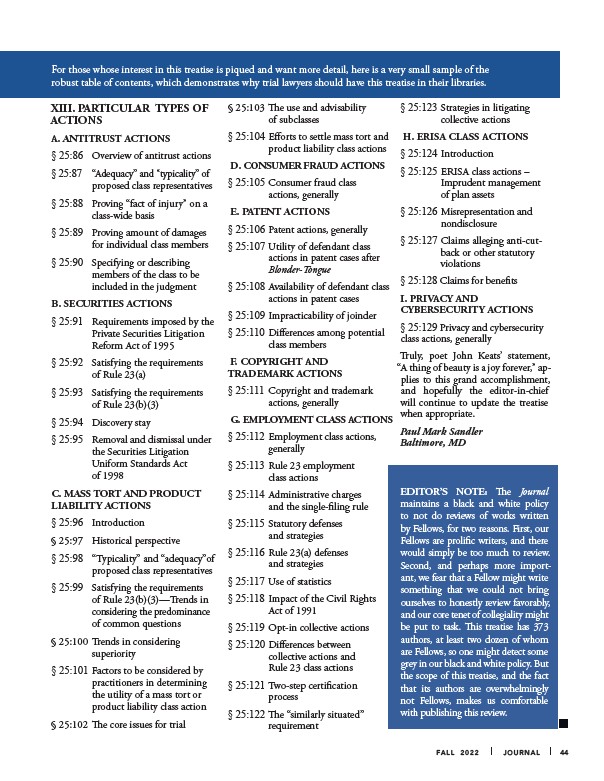
For those whose interest in this treatise is piqued and want more detail, here is a very small sample of the
robust table of contents, which demonstrates why trial lawyers should have this treatise in their libraries.
XIII. PARTICULAR TYPES OF
ACTIONS
A. ANTITRUST ACTIONS
§ 25:86 Overview of antitrust actions
§ 25:87 “Adequacy” and “typicality” of
proposed class representatives
§ 25:88 Proving “fact of injury” on a
class-wide basis
§ 25:89 Proving amount of damages
for individual class members
§ 25:90 Specifying or describing
members of the class to be
included in the judgment
B. SECURITIES ACTIONS
§ 25:91 Requirements imposed by the
Private Securities Litigation
Reform Act of 1995
§ 25:92 Satisfying the requirements
of Rule 23(a)
§ 25:93 Satisfying the requirements
of Rule 23(b)(3)
§ 25:94 Discovery stay
§ 25:95 Removal and dismissal under
the Securities Litigation
Uniform Standards Act
of 1998
C. MASS TORT AND PRODUCT
LIABILITY ACTIONS
§ 25:96 Introduction
§ 25:97 Historical perspective
§ 25:98 “Typicality” and “adequacy”of
proposed class representatives
§ 25:99 Satisfying the requirements
of Rule 23(b)(3)—Trends in
considering the predominance
of common questions
§ 25:100 Trends in considering
superiority
§ 25:101 Factors to be considered by
practitioners in determining
the utility of a mass tort or
product liability class action
§ 25:102 The core issues for trial
§ 25:103 The use and advisability
of subclasses
§ 25:104 Efforts to settle mass tort and
product liability class actions
D. CONSUMER FRAUD ACTIONS
§ 25:105 Consumer fraud class
actions, generally
E. PATENT ACTIONS
§ 25:106 Patent actions, generally
§ 25:107 Utility of defendant class
actions in patent cases after
Blonder-Tongue
§ 25:108 Availability of defendant class
actions in patent cases
§ 25:109 Impracticability of joinder
§ 25:110 Differences among potential
class members
F. COPYRIGHT AND
TRADEMARK ACTIONS
§ 25:111 Copyright and trademark
actions, generally
G. EMPLOYMENT CLASS ACTIONS
§ 25:112 Employment class actions,
generally
§ 25:113 Rule 23 employment
class actions
§ 25:114 Administrative charges
and the single-filing rule
§ 25:115 Statutory defenses
and strategies
§ 25:116 Rule 23(a) defenses
and strategies
§ 25:117 Use of statistics
§ 25:118 Impact of the Civil Rights
Act of 1991
§ 25:119 Opt-in collective actions
§ 25:120 Differences between
collective actions and
Rule 23 class actions
§ 25:121 Two-step certification
process
§ 25:122 The “similarly situated”
requirement
§ 25:123 Strategies in litigating
collective actions
H. ERISA CLASS ACTIONS
§ 25:124 Introduction
§ 25:125 ERISA class actions –
Imprudent management
of plan assets
§ 25:126 Misrepresentation and
nondisclosure
§ 25:127 Claims alleging anti-cut-
back or other statutory
violations
§ 25:128 Claims for benefits
I. PRIVACY AND
CYBERSECURITY ACTIONS
§ 25:129 Privacy and cybersecurity
class actions, generally
Truly, poet John Keats’ statement,
“A thing of beauty is a joy forever,” applies
to this grand accomplishment,
and hopefully the editor-in-chief
will continue to update the treatise
when appropriate.
Paul Mark Sandler
Baltimore, MD
EDITOR’S NOTE: The Journal
maintains a black and white policy
to not do reviews of works written
by Fellows, for two reasons. First, our
Fellows are prolific writers, and there
would simply be too much to review.
Second, and perhaps more important,
we fear that a Fellow might write
something that we could not bring
ourselves to honestly review favorably,
and our core tenet of collegiality might
be put to task. This treatise has 373
authors, at least two dozen of whom
are Fellows, so one might detect some
grey in our black and white policy. But
the scope of this treatise, and the fact
that its authors are overwhelmingly
not Fellows, makes us comfortable
with publishing this review.
FALL 2022 JOURNAL 44